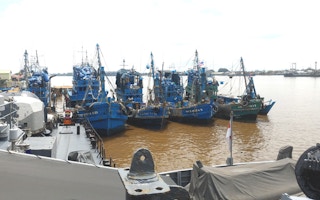A convoy of blue Thai fishing boats slowly entered the mouth of the Kapuas River near Pontianak, the capital of Indonesia’s West Kalimantan province, escorted by an Indonesian warship.
The boats were directed to moor at the local Navy base, about 62 nautical miles from the site of their capture. The crew were transferred to the warship. There they sat on the deck.
A naval personnel pointed to a fisherman in a rumpled blue shirt. His name was Sam Phong, 28. He could speak a bit of Indonesian, though not fluently. Still, his words shed a bit of light on why he had so diligently been fishing illegally in Indonesian waters.
Phong said his employer had guaranteed safe passage for his crew. The golden ticket? “If the authorities show up, just give them some money,” he explained.
Phong and 61 other fishermen made up the five Thai vessels’ crew. The ships were dragging banned trawl nets along the ocean floor in search of Indonesian fish.
According to Phong, the vessels were small and agile so as to avoid the navy and Maritime Affairs and Fisheries Ministry patrols.
“There are a lot of fish here,” he said. “I’ve already been here a year. With each catch, our fiber casks are always full. Each cask measures 200 liters, and each ship carries 40 or 50 of them.”
After reaching capacity, the five ships head toward Malaysia, where a buyer is waiting. When the transaction is completed, the crew are paid. Then they return to Indonesia and do it again.
The boats carry three flags: Thai, Indonesian and Malaysian. They decide which to hoist based on whose territory they are in.
Phong said he wasn’t familiar with Indonesian fishing regulations. It was the captain who determined where to sail and lower the net. “I just work,” Phong said.
Informed that trawl fishing can destroy certain types of fish and damage marine ecosystems, he shrugged it off. “There are many fish in the sea,” he replied. “Its limitless.”
Produced in English by Philip Jacobson.










